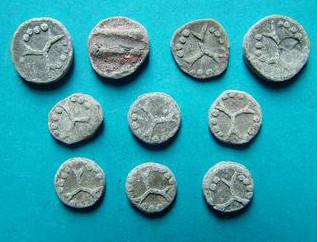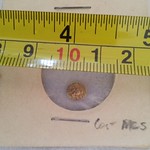
PREV ARTICLE
NEXT ARTICLE
FULL ISSUE
NUMISMATIC ITEMS, SMALL AND LARGELast week Dick Johnson wrote: "So where is the boundary line for what is numismatic? For my databank I have arbitrarily chosen 18 inches as the top size. Anything smaller could be collected by an individual. Anything larger would more than likely be in the collections of institutions." Martin Purdy writes: I have a block of Chinese "tea money" that is something like 12 x 10 x 1 inch, so that at least fits within Dick's arbitrary maximum. However, a large spike-like object in our little "ethnographic collection" is getting close to 30 inches in length, which would push the limits out a little further! Not really suitable for a 2x2, album, wallet or even air travel these days. I'm not entirely sure of the attribution of the spike yet. One source suggests West Africa, another Mexico.
I photographed the spike against a tape measure today (about 29.5 inches) and also a little gold fanam, which I left in its 2x2 for comparison. It's about 6mm or 1/4 inch across.  Last week Dick wrote: "We know the smallest coin, at least struck in America, is the "Panama Pill" the 2 1/2 centesimos with a diameter of 10mm." David Powell writes: May I draw your attention to my Lead Token newsletter again, where page 2 of LTT_69 {Jan 2011} describes some strange little pieces, of diameter 8mm and 9½ mm, found in Herefordshire. These are probably as small as anything found in Britain; the normal minimum even for late mediaeval and Elizabethan pewter tokens is only 11mm, with just very occasional specimens falling to 9mm or 10mm. Other candidates vying for the privilege of smallest coin are some of the 16/17th cent silver pieces of Imperial Russia, described by A.S.Melnikova in "Russian Coins from Ivan the Terrible to Peter I ", the worst of Rome's barbarous radiates and 5th cent minims, and the comparatively modern issues of the Indian state of Travancore. I reckon that the last-mentioned probably win; the smallest Travancore piece in one of my copies of Krause is under 5mm across {c.1809-10}, and even at the beginning of the 20th cent they were still making a few types with diameters of around 9-10mm. "Under 5mm" feels about the size of a large full stop. How the things were used for any practical purpose, and what the locals thought of them, I cannot imagine. Below is the full text of David's article. Thanks! -Editor
Introducing the Pb6…. Those of you familiar with the small Roman copper series of the 3rd to 5th centuries may be familiar with the terms AE1 through AE4, used to describe the denominational value of pieces in an era sufficiently obscure that no-one now living has any totally reliable idea of what exactly they were worth. The old well-understood series of sesterius, dupondis, denarius, semis and quadrans had long since gone and, the replacement system of small change being inadequately discussed in literature, we are left to describe copper coin denominations in terms of diameter, as follows: AE1: >25mm
  In fact, the scale should probably have been taken one step further, if 4mm bandwidths are assigned as above. The most horrible 5th cent minims and barbarous radiates go down to 11mm frequently and 9mm on occasion, so probably we should have AE4 = 13- 17mm and AE5 = 9-13mm. Our own English 15th and 16th lead hits similar minima, so Pb4 and Pb5 would not be unreasonable, if one were to adopt the same approach; I’m not suggesting we do, I am happy to use diameters. End of issue; surely nobody would be so stupidly impractical enough to go down below 9mm, would they….? The Indian state of Travancore was notorious for the small size of some of its pieces, the tiniest of which just about hit this figure; one can imagine only the tiny silver slivers of 17th cent Russian kopeks getting close. One looks at them and feels glad not to have lived in a place where such ridiculous things were forced upon the population. Most of the earlier 17th cent main series tokens would be AE4, and they are small enough in the hand; pity our Londoners c.1500 with their Pb5s, but at least we never reached the excesses of Russia and Travancore. Or so I thought until I recently encountered the little group above, which just happen to come from Herefordshire. They may look large on paper, but in fact the magnification factor is about 1.7; the small ones are around 8mm, the large ones about 9½mm. Probably, the latter are worth twice as much as the former. The design is quite fine and several of them are in moderately good condition, despite the dimensions. The design, a triquetra {three-legged figure} with varying degrees of forking at the end of the arms, is consistent in concept if not always in execution, and the quartet of pellets seems to be invariable. There are never three, never five; which other of our crude lead manufacturers would have been that consistent? In other words, considering their size, they are of a fair standard of manufacture. One wonders how such miniscule proportions would have tested the makers' skills. 8mm, might I say, would be Pb6! The weights are greater than one might think; the big ones in the sample scale at between 1.13gm and 1.29gm, whilst the seven small ones all lie in the quite compact range of 0.56gm to 0.67gm. Those with a keen eye may also note a counterstamp on the largest one, depicting a plain threelegged cartwheel in miniature. Would you really enjoy using such pieces regularly? To read the complete January 2011 Leaden Tokens Telegraph issue, see:
Ken Spindler of San Diego writes: Dick Johnson's discussion of the size parameters for "numismatic items" considers only metallic issues. As a part of my collection of 1790s French Revolution money, I collect uncut sheets of French assignats, by type. I own a dozen sheets of different national issues, not counting examples with alternate signature combinations. The largest two measure about 15" x 20-1/2". Also a sheet of watermarked paper - an awfully expensive blank piece of paper! - prepared for a denomination that was authorized but never printed because the new currency system, promesses de mandats territoriaux, failed so quickly; and a printer's proof sheet of a municipal paper money issue, billet de confiance. I figure they must be about the physically largest collectable numismatic pieces, next to Yap Island stone money or other bulky odd-and-curious with very narrow if any commercial function. Of course it's entirely possible there are even larger uncut sheets of paper currency out there than mine. But not necessarily more interesting; size isn't everything. To read the earlier E-Sylum article, see:
Wayne Homren, Editor The Numismatic Bibliomania Society is a non-profit organization promoting numismatic literature. See our web site at coinbooks.org. To submit items for publication in The E-Sylum, write to the Editor at this address: whomren@gmail.com To subscribe go to: https://my.binhost.com/lists/listinfo/esylum All Rights Reserved. NBS Home Page Contact the NBS webmaster 
|
